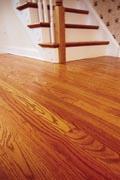US researchers suggest that old wood floor finishes may be an overlooked source of the environmental pollutants polychlorinated biphenyls (PCBs)

A small study, published recently in the online journal Environmental Health, suggests that old wood floor finishes may be an overlooked source of the environmental pollutants polychlorinated biphenyls (PCBs).1
Polychlorinated biphenyls are persistent organic pollutants. They accumulate in the food chain and have been identified worldwide as human blood and breast milk contaminants. They were widely used in industry as cooling and insulating fluids for electrical equipment as well as in construction and domestic products, such as varnishes and caulks. PCBs were banned in the 1970s because of their high toxicity.
Ruthann Rudel and Julia Brody of the Silent Spring Institute in Newton, Massachusetts, and Liesel Seryak, of the Ohio State University, Columbus, previously measured PCBs in indoor air in homes in Cape Cod, during 1999-2001. They found detectable levels of PCBs in almost one in three of 120 residences. However, two of the homes had much higher concentrations of PCBs than the others. The researchers have now re-tested those homes to verify the initial finding, as well as evaluating blood PCB concentrations of residents.
From their results they found that air and dust concentrations remained elevated over five years between initial and follow-up sampling. Residents showed higher levels of PCBs in their blood serum compared to the 95th percentile of a representative sample of the US population.
The source of the PCBs was brought to light when a resident reported that PCB-containing wood floor finish, Fabulon, had been used in the home in the past. Moreover, the floor of one room had been sanded and refinished immediately prior to sample collection.
The researchers point out that PCB-containing products such as floor finishes and caulks will have been used in many buildings, including schools and public buildings, during the 1950s and 1960s. 'Our findings suggest that the exposure potential posed by historic use of PCBs in building materials may be significantly underestimated', the researchers say.
Related Links
An online journal published by BioMed Central
References
- R. Rudel, J. Brody and L. Seryak, Environ. Health






No comments yet